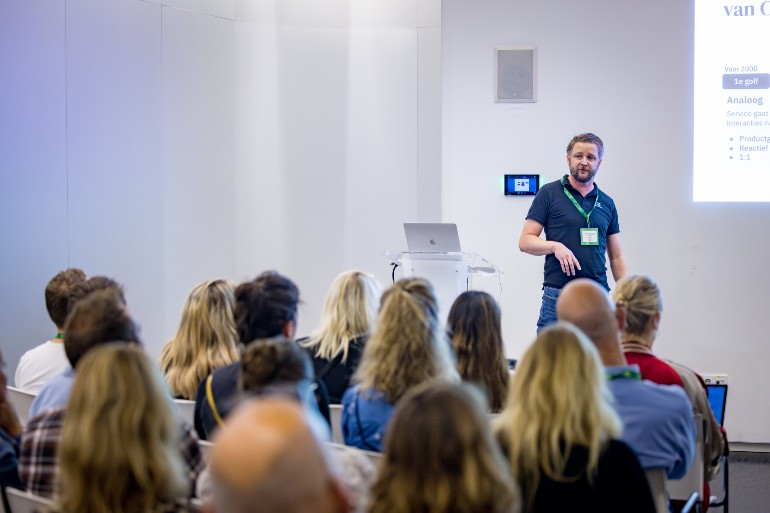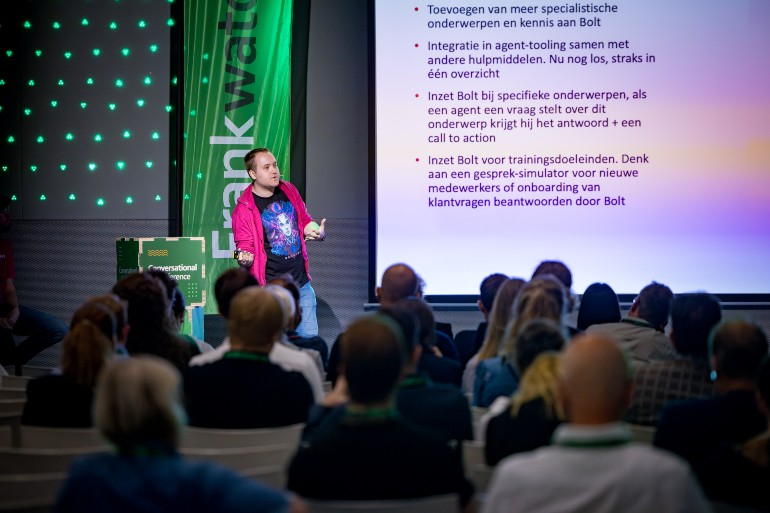The AI revolution has reached the world of customer contact and conversational. Will chatbots and agents with the support of AI finally deliver that perfect customer experience? Companies such as KPN and Essent are taking up the challenge.
Conversational Conference 2024
On Thursday, September 19, the time had come: the 9th edition of Conversational Conference. The event about conversational AI and digital customer contact. The program was full of inspiring keynotes, breakout sessions, workshops from KPN, Zilveren Kruis, Essent, Rabobank, Arriva and Knab, among others. This time there was also an exciting and at times hilarious panel discussion with Picnic, Huxam, bol and Watermelon about the place of GenAI in customer contact.
But let’s not forget the many questions and discussions from the 300+ participants. What do you mean, competition? The conversational community was there to talk to each other and learn from each other.
Photographer: MichielTon.com
From CX-trends
Next year will be the 10th anniversary of this event and that made me think back to previous editions, when a term like ‘conversational design’ was still emerging. And while people were already dreaming about AI, it was still mostly a pipe dream. But during Conversational Conference 2024 it quickly became clear that companies are now really experimenting with it.
In the meantime, the third wave of CX disruption started, sets Pim Swan (Senior Solution Consultant at Zendesk) during his trend presentation. And it revolves around the rise of Generative AI (GenAI). From research from Zendesk, 70% of CX leaders plan to add GenAI to multiple touchpoints in the customer experience over the next 2 years. The entire customer experience is being re-examined.
70 percent of CX leaders want to add GenAI to the customer experience in the next 2 years.
Zendesk also predicts that AI will touch 100% of all customer interactions, and that AI will be able to handle 80% of interactions on its own, without human intervention. What will that leave for human agents? More time to handle complex queries. AI can also help to alleviate the shortage of employees… and perhaps even increase the salaries of those employees, if you continue to allocate the same budget to customer service.

Photographer: MichielTon.com
How KPN uses conversational AI to help customers
So what does the use of AI look like in practice? We can learn from KPN, which has a ‘AI-powered company‘ wants to be. AI automation is part of the strategy for 2024-2027, says Mark Wessel (Product lead digital channels at KPN) during his keynote. And that strategy is digital first, app-centric in human assisted. Every customer journey starts digitally, with the app as the preferred channel. In the customer journey, contact must always be relevant and personal based on a complete customer image. And when necessary, there is easy support from an expert.
But for an optimal, seamless customer journey, you need the right data and systems. How do you best help the customer? This is different for each customer and question. For example, think of older people who do not necessarily want to talk to a chatbot or young people who prefer to use WhatsApp. KPN uses an ‘intelligent decision engine’ that decides how each contact can best proceed. This engine currently mainly works on business logic, but towards the end of 2024 the transition will be made to machine learning.

Photographer: MichielTon.com
Dot, from digital assistant
The digital assistant Dot is used for customer contact. Dot is in the heart of the digital strategy and is omnichannel: you can contact the bot via the site, the app and voice. The bot has two functions:
- a guide who guides people through the services
- a bridging function to human employees, where Dot connects customers to the right employee on the right channel
Dot is also slowly becoming a real assistant. For example, the bot can ensure that the customer is called back by an employee instead of waiting. This provides a better, seamless experience, because the conversation context and data are already forwarded to the employee. And it also helps KPN to spread the crowds.
Mark’s dream is that in the future the bot can help at the same level as an employee. And something else to think about: if people will have personal assistants who can perform tasks themselves (think Google Assistant or Siri), then you will have to deal with bots that talk to bots. How do you deal with that? And what if natural language becomes the operating system of the future? Something to think about and prepare for.
The challenges of AI for customer contact
Mark Wessel also shared some challenges and risks for deploying AI:
- Quality. How do you validate that the answer given by the assistant comes from the data (for example your knowledge base) and is not made up (i.e. hallucinated)?
- RAG application. How do you deal with multiple content sources for the same customer journey?
- Performance. How do you ensure a good balance between performance, quality and security?
- Testing and evaluation. How do you evaluate and measure the quality of conversations?
Bolt: from internal bot van Essent
While KPN works with a bot for customer contact, Essent has built a bot for internal use in a short time: Bolt. Early 2024, Kellin Sjoerds in Ricky Rekkers (both AI engineers at Essent) found that customer advisors spent a lot of time searching for answers in the knowledge base, while they could better spend that time helping customers. In addition, senior advisors also spent a lot of time supporting new colleagues in finding answers.
During a hackathon in January 2024, the bot Bolt was built as a solution to these challenges. Based on the customer advisor’s question, Bolt searches for the most relevant article in the knowledge base and formulates the answer based on GenAI and provides the source. This way, the advisor can always read the entire article.
Bolt has produced surprisingly positive results so far. For example, the average handling time of telephony has dropped by as much as 60 seconds. The average handling time via chat has dropped by 50 seconds. And senior customer advisors no longer have to support their colleagues, those helplines have even been closed.

Photographer: MichielTon.com
The Challenges & Lessons of an Internal Assistant
Kellin and Ricky share some of the challenges and lessons they learned from Bolt:
- About hallucinations To prevent this and ensure that Bolt actually follows the instructions, the temperature has been set to 0.
- About relevant answers to provide, the prompt has been improved in steps, including instructions such as ‘do not ask for further questions’ and ‘always answer based on the sources’.
- Make sure that legal has been included from the start, so that the bot always complies with guidelines and legislation.
- Involve knowledge management when optimizing the knowledge base for the bot. They discovered that texts with a fixed format yield better results. This may not be necessary with future, better AI models, but so far it helps.
- Accompanied klantadviseurs when rolling out the bot and provide instructions on how to use your bot.
What do you mean, future? It’s now!
If one thing became clear during Conversational Conference 2024, it is AI no longer a futuristic concept is. It is a reality that is already impacting customer service and interaction. And looking ahead, customer contact will soon be characterized by hyper-personalization, proactive service and a seamless mix of bot and human interaction.
For companies considering implementing AI in their customer experience, the message is clear: it’s time to get started. Start small, experiment, and build on successes. Involve all stakeholders from the start, from customer service to management. For a seamless customer experience, from website to app to phone, good integration and linking of systems and data is important. This is the biggest challenge for companies right now. And let’s not forget: making mistakes is part of life, but make sure you have a safety net for them and can continuously improve.
While AI will likely handle a large portion of customer queries in the future (from predictions to 80% self-service), human contact will remain important. Not only for complex queries, but also for customers who prefer to talk to real people.
Source: www.frankwatching.com


